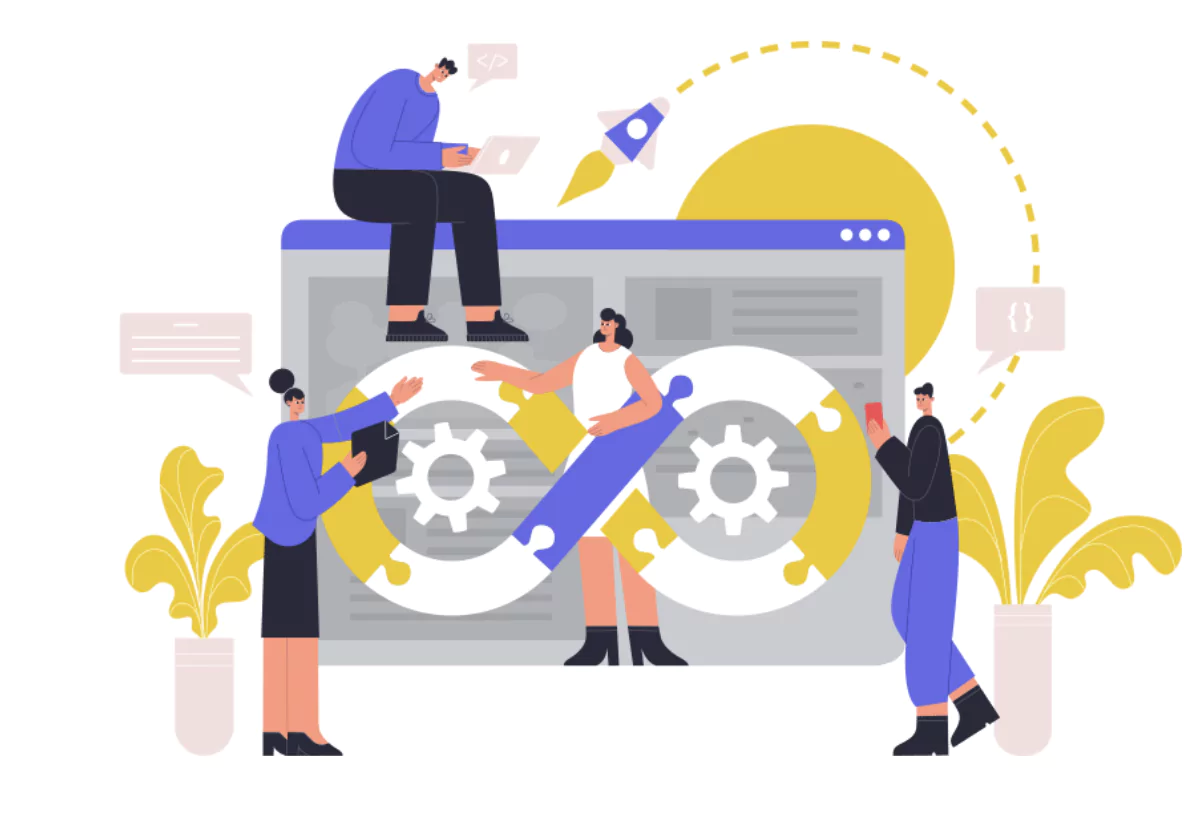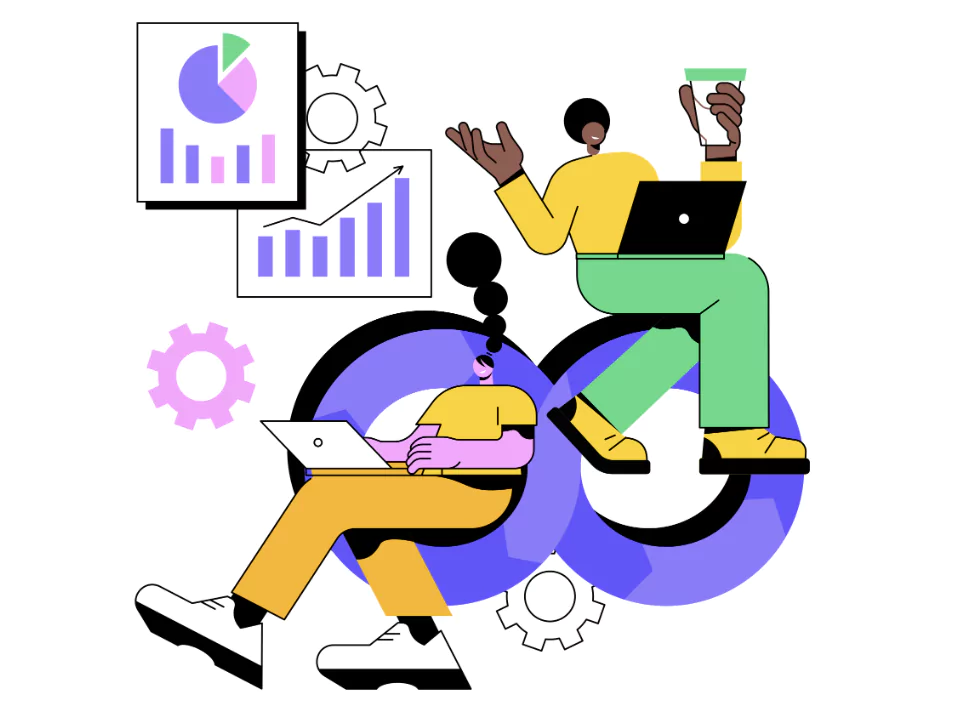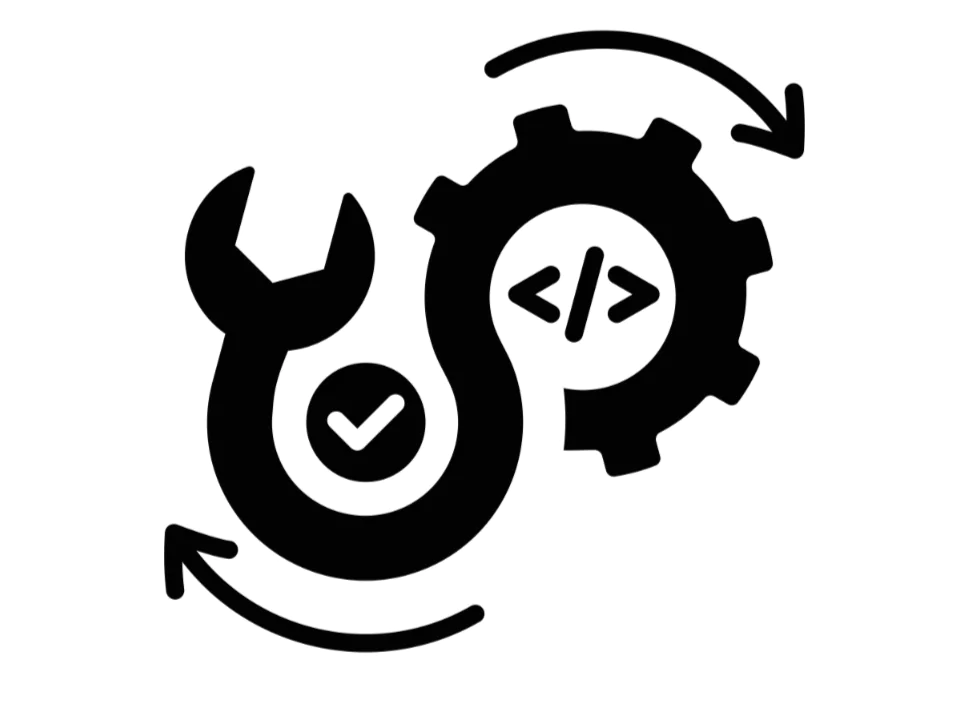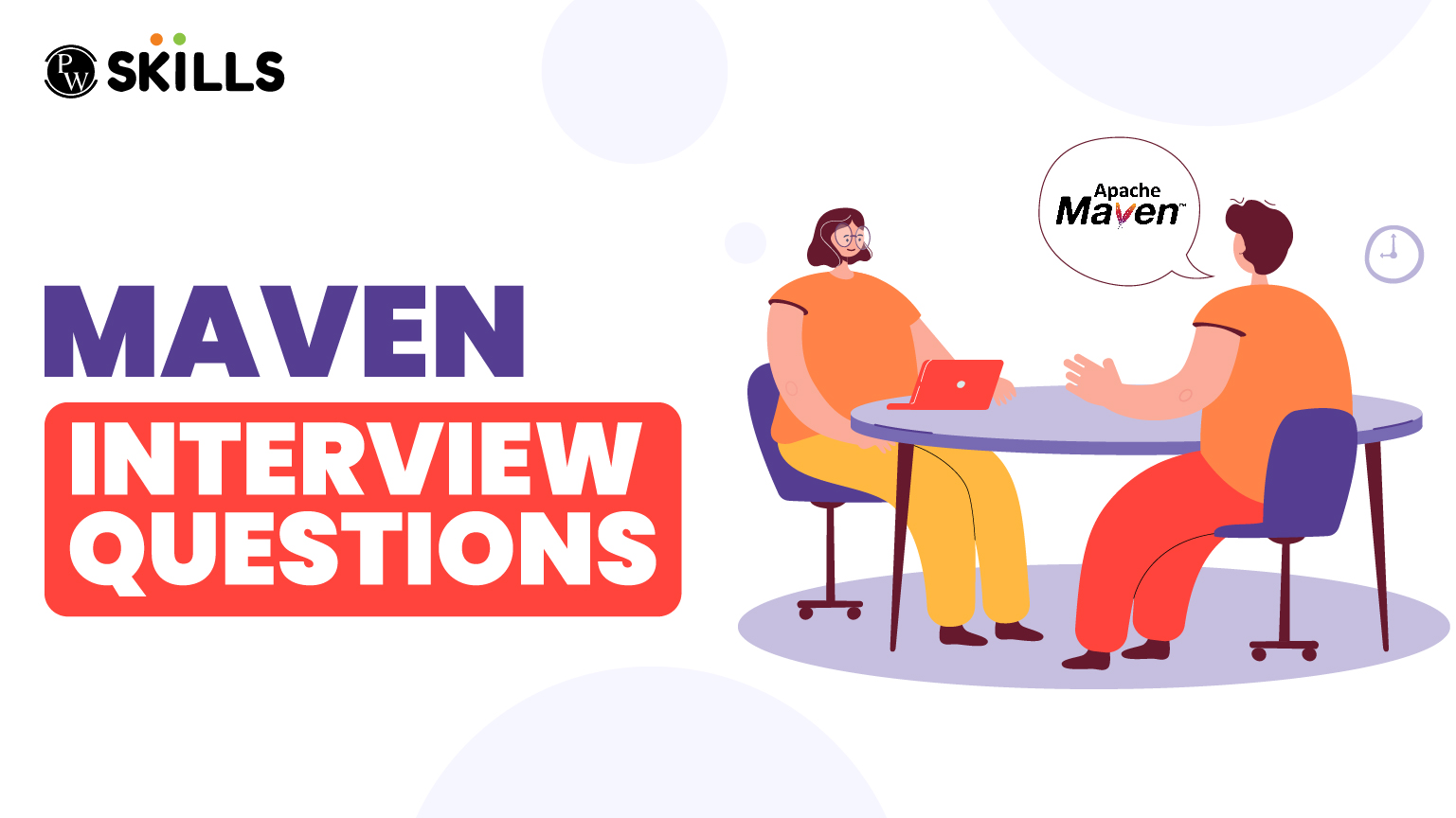Maven Interview questions are frequently asked during devOps based roles. This framework is a powerful automation and project management tool which is used for java based projects mainly. It simplifies the process of building, testing, and deploying applications by managing various configurations and dependencies.
Maven is highly used for automation, managing project dependencies, etc. In this blog, we will learn about some of the best Maven interview questions for beginners and professionals.
50 Maven Interview Questions And Answers For Freshers

Let us check some of the popular Maven Interview questions and answers especially for freshers.
- What is Maven?
Ans: Maven is a smart automation and project management framework used mainly for Java based projects. It easily contributes in managing dependencies, compiling code, packaging applications, and running tests using a very simple single configuration file called pom.xml.
- What are the main features of Maven?
Ans: The main features of Maven framework includes project build lifecycle, automation, dependency management, plugins, standardised project structure and easy integration with third party IDEs, CI/CD tools.
Read More: DevOps Team Setup 101 – Explore Powerful Future of Tech
- What is POM in Maven?
Ans: POM stands for Project Object Model in Maven which is an XML file with an extension of pom.xml. It contains information about the complete project, configuration details, dependencies, plugins, and build instructions.
- What is the default location of the POM file?
Ans: The POM file by default is located in the root directory of the Maven project. Maven looks at the POM files first before when they run a build or commands.
- What are Maven’s Build Lifecycle Phases?
Ans: There are three main cycles in Maven which are default, clean and site. The Maven Lifecycle automates the build processes in steps. Each life cycle has phases like validate, compile, test, package, verify, install and deploy.
- What is the difference between install and deploy in Maven?
Ans: The install copies feature in Maven is used to install copies of your built project to your local repository so the other projects or machine can use it. Deploy is used to send the final confirmed build to a remote repository generally used in team collaboration or production.
Read More: How DevOps Works? Easy Explanation
- What is a Maven Repository?
Ans: A Maven repository is a type of storage location where libraries, plugins, and other build artifacts are easily kept. There are three types which includes
- Local: Stored in native machine
- Central: It is a default line repository
- Remote: It is a custom company hosted repository
- What is the Local Repository in Maven?
Ans: The local repository is a folder stored in your system where Maven caches downloaded dependencies. It helps prevent downloading the same files multiple times. It’s usually located at ~/.m2/repository.
- What is the Central Repository?
Ans: Maven Central Repository is a public online repository which can host a large list of open source java libraries. Dependencies can be declared with open-source java libraries. If the dependency is not found in the local then maven searches it in the Central.
- What is a Remote Repository in Maven?
Ans: Remote Repository in Maven is used to store internal or third party libraries which are not available on Maven central. It is a type of manual configured repository hosted on organisation servers or external servers.
- What are Maven Coordinates?
Ans: Coordinates are the unique identifiers for a Maven artifact, groupId, version, artifactId, often packaging. These feature coordinates in Maven help Maven identify and retrieve the correct files.
- What is a Dependency in Maven?
Ans: A dependency in Maven is an external Java based library which is required by your project to run. It is an external library with files like JAR, zip, etc which you will need to compile, test, build, and run.
- What is Transitive Dependency?
Ans: In Marven, Transitive dependency can be considered as dependencies of your dependencies. This dependency is automatically resolved by Marven. There is no need to manually include them in every nested library.
- What is a Plugin in Maven?
Plugins in Maven can be used to perform several tasks such as code compilation, test running, generating reports, JAR files, and more. You can configure them in the POM build section.
- What is the difference between compile and package phase?
Ans: Compile phase is used to translate your source code into simple bytecode i,e. Compile the Java source code into bytecodes. After the test phase completes then the package phase bundles the compile code, resource, and dependencies together after it passes the test.
Read More: Example Of Java Programming Language
- What is a Maven Archetype?
Ans: An archetype is a template used for generating new projects. It simply sets up a standard product structure with some sample files to take as a reference. You can either use one of the built-in Archetype or build your own version.
- What is a SNAPSHOT version in Maven?
Ans: A SNAPSHOT in Maven is used to keep a development copy of the progress of the product and is flexible unlike the release version of the product which is fixed.
- How do you add a dependency in Maven?
Ans: You can simply add dependency in Maven using the <dependencies> tag in the form of xml tags and extension i,e. pom.xml which provides all information about the groupID, artifactID, and version.
- What is the scope of a dependency in Maven?
Ans: Dependency in Maven is used to define how and when dependency is to be used in the following situation i,e. During compile, runtime, test, system, and import.
Read More: The 20 Most Important DevOps Trends in 2025: Beat the Game
- What is the purpose of the clean phase?
Ans: The task of clean phase is to delete files from previous builds to provide new fresh builds every time. It is usually taken from the directory.
20 Intermediate Maven Interview Questions and Answers

Are you already familiar with the basics and looking out for some of the frequent Maven interview questions, check below for some frequently asked questions from interviews.
![]() Join Our Devops & Cloud Computing Telegram Channel
Join Our Devops & Cloud Computing Telegram Channel
![]() Join Our Devops & Cloud Computing WhatsApp Channel
Join Our Devops & Cloud Computing WhatsApp Channel
- How does Maven handle version conflicts in dependencies?
Ans: Maven takes help of the nearest win strategy to resolve version conflicts in dependencies. It picks the closest dependency in the tree hierarchy and during comparison if two dependencies declare different versions of the same library then the one nearest to the project wins.
- What is the purpose of the dependencyManagement tag?
Ans: The dependencyManagement tag in Maven is used to define versions and scope for dependencies existing in parent POM while excluding them as active dependencies. They manage consistent versions across all modules in big multi projects.
- What is the difference between dependencies and dependencyManagement?
Ans:
| Dependencies | dependencyManagement |
| Dependencies adds a dependency to the current project. | Dependency management is used to control dependency versions and scope for child modules. |
| It is used in any pom.xml which can either be parent or child. | It is typically used in the parent POM. |
| The dependencies often are immediately included in build. | Dependency management is not added to dependency unless it’s also declared in child. |
| They are inherited and active in child projects. | They are inherited but only applied when used explicitly in the project |
| It cannot reduce duplication can lead to repeated version declarations. | Yes it can centralize version and scope declarations for reducing duplications. |
| When you want to use a library in your project you can use dependencies in Maven. | When you want to standardize dependency versions across modules. |
- How does Maven support multi-module projects?
Ans: Maven is a multi-model setup which can create a parent project that can be used to list child modules using the <module> tag. This will allow all modules to share a common configuration at one time.
Read More:
- What is the role of the super POM in Maven?
Ans: The Super POM is a default POM from where all projects inherit when no parent is explicitly defined. It contains default configurations like URLs, Plugin settings, repository URLs, and more.
Read More: What is AWS DevOps? | Architecture, Tools, and Benefits in 2024
- What are Maven profiles and how are they used?
Ans: Maven profiles offers you to customize builds used for different environments where you can also define profiles in the POM and activate them using the command line or based on different conditions.
- How can you skip test cases while building a Maven project?
Ans: You can use the -DskipTests flag with your Maven to skip test cases in building a Maven project.
- What is the use of the site lifecycle in Maven?
Ans: The site lifecycle in Maven can be used to generate documentation related to your project consisting of important components like metrics, source links, reports, and more. It can easily be executed using the mvn site,
- What’s the difference between build and pluginManagement?
Ans: Build section is used to define the plugin that are used in the current project while the pluginManagement is used with the parent POMs to define default plugin versions and configurations for child projects.
- How can you override a plugin’s configuration?
Ans: You can easily override the configuration of a plugin using the pom.xml inside the <build> section. You can change the objective, findings
- What is the use of the mvn dependency:tree command?
Ans: The tree command shows the complete full hierarchy of dependencies including the transitive ones. It is useful for debugging conflict versions and understanding which dependencies are being included inside.
- What is a BOM in Maven?
Ans: Bill of Materials is the full form of BOM which is a special POM that is used in dependencyManagement to control all versions of a group and centralise a group of dependencies.
- How do you deploy a Maven project to a remote repository?
Ans: You can configure the remote repository URL and credentials inside the pom.xml and then run. You also have to upload the artefact to the specified remote repository.
Read More: DevOps Course Syllabus: What is Taught in DevOps Course?
- What is the difference between provided and compile scope?
Ans: The compile Scope in Maven includes the complete dependency in both compile and run time. Provided is the dependency needed for compilation which will be provided during the runtime.
- How do you define a custom lifecycle or phase in Maven?
Ans: Maven does not have an option for creating a new lifecycle directly but you can bind the goals of the customer plugin to the existing phases with the <execution> tag.
- How can Maven be integrated with CI/CD tools like Jenkins?
Ans: Maven can easily be integrated with Jenkins through pipelines or job type. Jenkins can easily trigger all Mavin builds using goals like install, clean, and artificats which can be deployed as a pipeline part.
- What is the use of the target directory in Maven?
Ans: The target directory in Maven is the place where Maven places all the build output i,e, compiled classes, packaged JAR/WAR files, reports, and temporary files.
- What happens if a dependency is not found in any repository?
Ans: When a dependency is not inside the remote, local or central repositories then it will show a build error on the screen which you can fix by manually installing a dependency which is missing. The command for installing is given below.
| mvn install:install-file |
- How can you analyze Maven build performance?
Ans: You can use the command mvn-x to debug the output or you can also use some profiling tools like mvn clean install, Dprofile to analyze performance, etc.
- How do you handle circular dependencies in Maven?
Ans: Maven has no support for circular dependencies. It is greatly recommended for codebase to eliminate them often by extracting the shared logic into a separate module that both projects can depend on.
Read More: DevOps Learning & Comprehensive Guide
10 Advanced Maven Interview Questions & Answers

Check some of the major advanced Maven interview questions and answers for working professionals in devOps or related fields.
- How does Maven handle dependency version conflicts in complex multi-module projects?
Ans: Maven uses Nearest win strategy to solve conflicts. However, in multi-modules project managing versions become important which can be done using BOM or the dependencyManagement sections in the POM.
- What are best practices for using Maven in a CI/CD pipeline?
Ans: Some best practices to be used in CI/CD pipeline with Maven are given below.
- You must use Maven with repeatable commands such as mvn package, mvn clean verify, and more.
- Leverage caching of the local repository for speed
- Use profiles for environment-specific configs
- Deploy artifacts securely using mvn deploy to Nexus or Artifactory with proper credentials
- What’s the difference between mvn install and mvn deploy in enterprise Maven workflows?
Ans: MVN install is used to place the built artifact into the local repository which makes it available for local use. MVN deploy on other hand sends the complete artifcat into a remote repository which can easily be used by other team members.
- How do you create and manage a custom Maven plugin?
Ans: You can easily create a custom Maven plugin by building a new Maven project including maven-plugin packaging. You have to define the goals using Java classes with annotations or by extending AbstractMojo. When completed packaging it is time to install it locally with mvn install, and then reference it in your other projects like any standard plugin.r
Read More: What is AWS DevOps? | Architecture, Tools, and Benefits in 2024
- What strategies can be used to reduce Maven build time in large projects?
Ans: You can use the following strategies to reduce maven built time for large projects.
- Parallel builds (mvn -T 1C install)
- Build caching with CI tools (e.g., caching .m2/repository)
- Avoiding unnecessary plugins
- Using incremental builds or splitting modules logically
- Avoid SNAPSHOT dependencies in production builds for stability and speed.
- How do you configure authentication for Maven deployments to a private repository?
Ans: You can use tools like password encryption which is used to store encrypted credentials. Also you can use the <servers> tage section in ~/.m2/settings.xml
- What is the Maven Enforcer Plugin and how is it useful?
Ans: The Maven Enforcer Plugin is used to enforce rules and policies in your build using Maven. It can also restrict usage of banned dependencies, enforce Java versions, or prevent duplicate or conflicting dependencies. It is often used in large teams to maintain consistency and compliance.
- How do you manage shared configurations across multiple Maven projects?
Ans: You can use a parent POM to define all shared settings such as dependency versions, repositories, plugin versions, and other properties. There are child modules which can be used to inherit these settings and ensure consistency across the team or organisation.
- What are the advantages of using a BOM in dependency management?
Ans: A BOM is used to centralize the dependency versions especially for the related libraries. It can also be used to avoid version mismatches. It Is important to follow the command below.
| xml
<dependency> <groupId>…</groupId> <artifactId>…</artifactId> <version>…</version> <type>pom</type> <scope>import</scope> </dependency> |
- How does Maven support reproducible builds?
Ans: Maven promotes reproducibility using:
- Uses pom.xml configuration
- Consist of versioned dependencies
- Avoidance of LATEST or RELEASE tags
- Strong use of plugins like reproducible-build-maven-plugin
- Locking versions in BOMs and consistent build environments (e.g., Docker for builds)
Also Read:
- DevOps Interview Questions and Answers 2025: For Freshers & Beginners
- DevOps Career Path: Your Career Guide For 2025
- The 20 Most Important DevOps Trends in 2025: Beat the Game
- DevOps Engineer Salary in India: Fresher to Experienced Effective Pay Scale 5 Step Guide
Learn DevOps with PW Skills
Join our online DevOps Course and build strong basics in DevOps and cloud computing technology. Prepare for your AWS certification exam with industry experts. Master tools like Ansible, Terraform, Kubernetes, Jenkins, Dockers, and Cloud Computing and more.
Get in-depth learning through interactive classes, regular assessments, practice exercises, and work on industry-relevant projects throughout the course only at pwskills.com
Maven Interview Questions and Answers FAQs
Q1. What is Maven?
Ans: Maven is a smart automation and project management framework used mainly for Java based projects. It easily contributes in managing dependencies, compiling code, packaging applications, and running tests using a very simple single configuration file called pom.xml
Q2. Why is Maven used in DevOps?
Ans: Maven in DevOps is used to automate and standardise the dependency management and project configuration processes which makes the software development lifecycle easier and efficient.
Q3. Can Maven integrate with CI/CD tools?
Ans: Maven easily integrates with CI/CD and other devOps tools like Jenkins, GitLab, Ansible, and more.
Q4. Can interview questions help me in my Maven interview preparation?
Ans: You can strengthen your concepts and confidence both at the same time by getting yourself familiar with the concepts of Maven frameworks.

